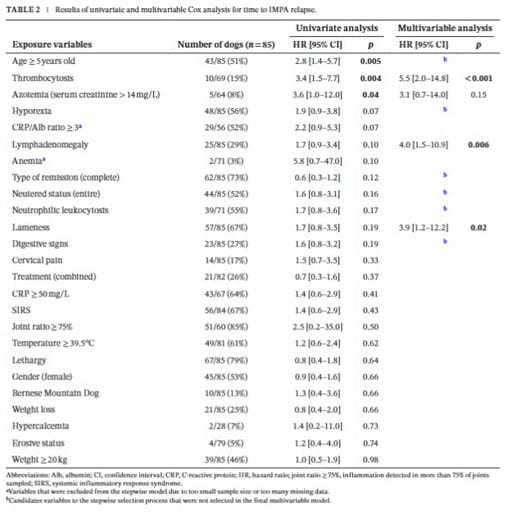- Veterinary View Box
- Posts
- Why Do Dogs with Immune-Mediated Polyarthritis Relapse? New Predictors Identified
Why Do Dogs with Immune-Mediated Polyarthritis Relapse? New Predictors Identified
Journal of Veterinary Internal Medicine, 2025
Diane Pichard, Thibaud Robin, Kevin Le Boedec, Christelle Maurey, Maxime Kurtz, Fiona Da Riz, Stéphane Blot, Morgane Canonne-Guibert, Mario Cervone, Emilie Krafft, Jean-Luc Cadore, Loïc Desquilbet, Ghita Benchekroun
Background
Idiopathic immune-mediated polyarthritis (IMPA) is a common inflammatory joint disease in dogs, characterized by multisystemic joint inflammation without an identifiable underlying cause. Despite generally favorable remission rates, relapse is frequent and its predictors are not well understood. This multicenter study aimed to describe outcomes of medical management in dogs with non-associative IMPA and identify clinical and laboratory variables associated with relapse.
Methods
A retrospective multicenter analysis was performed on dogs diagnosed with non-associative IMPA between 2010 and 2022 at four French referral centers. Inclusion required joint cytology consistent with neutrophilic inflammation in at least two joints, exclusion of infectious or secondary causes, and a minimum of one follow-up visit. Remission was defined as full or partial resolution of clinical signs and normalization of C-reactive protein (CRP). Relapse was defined as recurrence of clinical signs, CRP elevation, or both after remission. Data were analyzed using univariate and multivariable Cox proportional hazards models to assess associations between initial findings and time to relapse.
Results
Of 119 included dogs, 114 (95.8%) achieved remission—82 (71.9%) complete and 32 (28.1%) partial—with a median time to remission of 22 days. Relapse analysis was performed on 85 dogs with sufficient follow-up. The median time from remission to relapse was 6.5 months, with relapse rates of 43% at 6 months, 61% at 12 months, and 65% at 24 months. Multivariable analysis identified three independent predictors of shorter time to relapse: thrombocytosis (adjusted hazard ratio = 5.5), peripheral lymphadenomegaly (aHR = 4.0), and lameness at presentation (aHR = 3.9). Treatment type (corticosteroid monotherapy vs. combination) and remission type (complete vs. partial) were not associated with relapse risk.
Limitations
Limitations included the retrospective design, incomplete standardization of diagnostic and follow-up procedures, and potential overestimation of remission timing. Variation in clinician management and lack of standardized relapse assessment may also have introduced bias. Erosive and non-erosive forms were combined, possibly adding heterogeneity.
Conclusions
Medical management of non-associative IMPA in dogs results in high remission rates but a substantial risk of relapse, particularly within the first year after diagnosis. Thrombocytosis, lymphadenomegaly, and lameness at presentation are significant predictors of relapse and may reflect greater inflammatory burden or immune dysregulation. These findings highlight the importance of close monitoring and potentially extended immunosuppressive therapy in high-risk dogs.

How did we do? |
Disclaimer: The summary generated in this email was created by an AI large language model. Therefore errors may occur. Reading the article is the best way to understand the scholarly work. The figure presented here remains the property of the publisher or author and subject to the applicable copyright agreement. It is reproduced here as an educational work. If you have any questions or concerns about the work presented here, reply to this email.